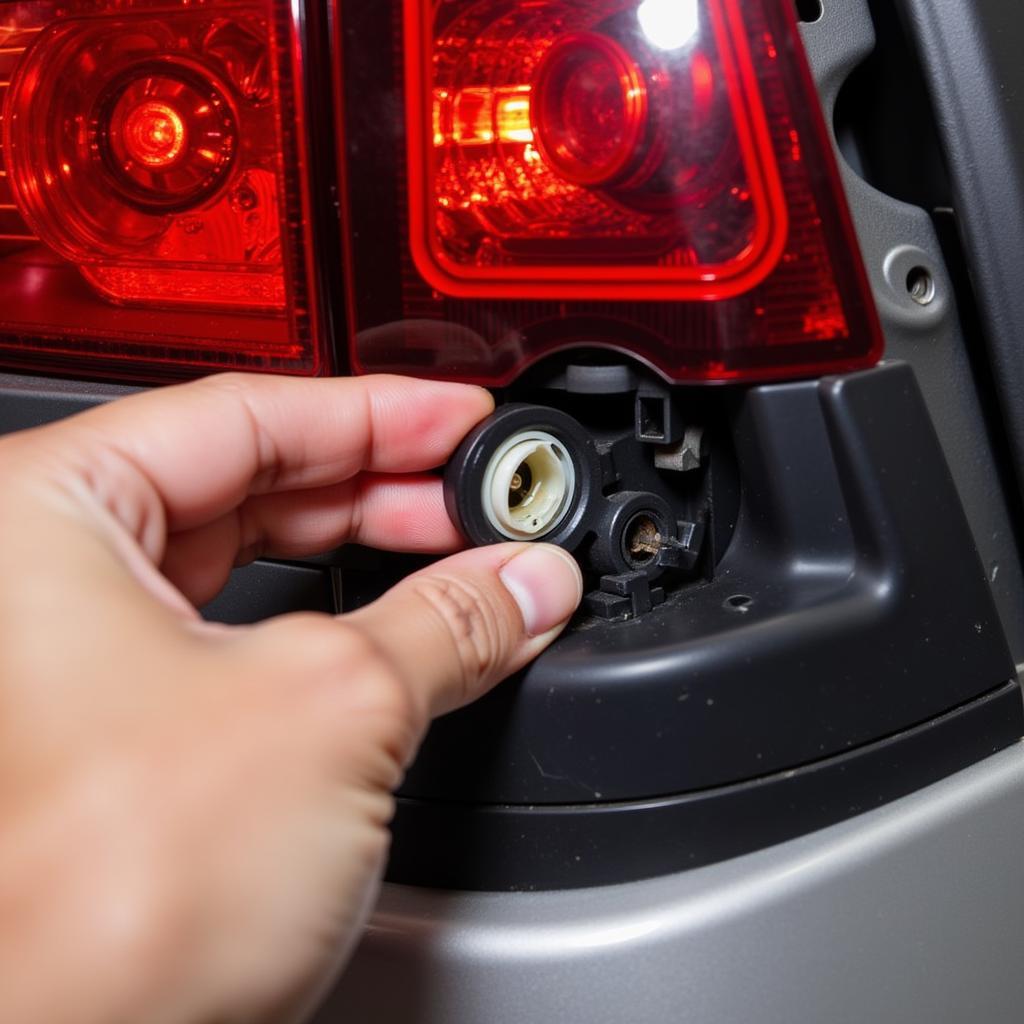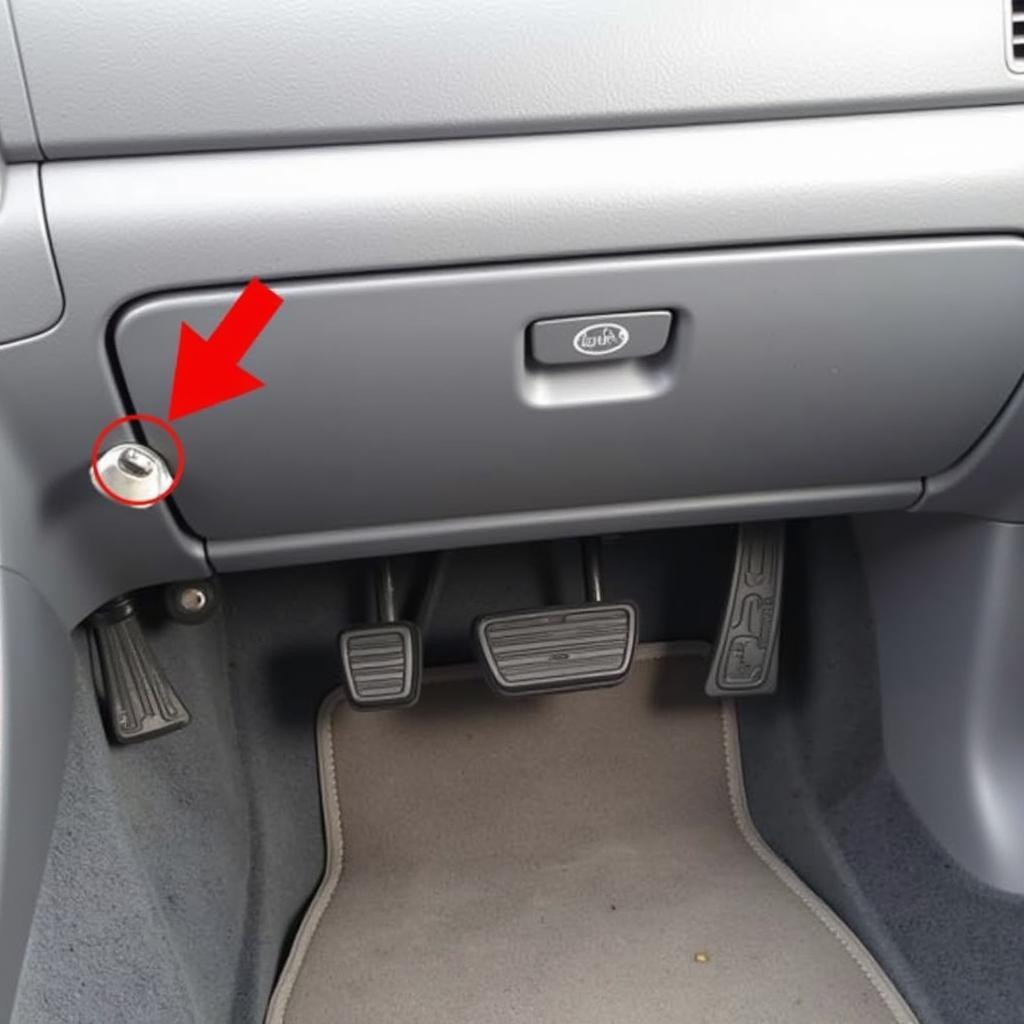A brake lamp warning light on your 2003 Acura TL is a clear sign that something isn’t right with your braking system. While it might seem like a minor annoyance, ignoring it could lead to dangerous driving conditions. This comprehensive guide will walk you through the common causes of a 2003 Acura TL brake lamp warning light and provide you with the information needed to diagnose and potentially fix the issue yourself.
Understanding Your Acura TL’s Brake Light System
Before diving into troubleshooting, it’s essential to have a basic understanding of your car’s brake light system. Your Acura TL uses a combination of components to alert other drivers when you’re slowing down or stopping:
- Brake Light Bulbs: These are the most obvious part of the system. When you press the brake pedal, these bulbs illuminate at the rear of your car.
- Brake Light Switch: Located above the brake pedal, this switch activates the brake lights when it senses pressure from you pressing the pedal.
- Fuses: Your car’s fuse box contains fuses dedicated to the brake light circuit. A blown fuse can interrupt the flow of electricity to the brake lights.
- Wiring: A network of wires carries electrical signals between the brake pedal switch, fuses, and the brake light bulbs.
Common Causes of a 2003 Acura TL Brake Lamp Warning Light
There are several reasons why your 2003 Acura TL brake lamp warning light might be on. Here are some of the most frequent culprits:
1. Burnt Out Brake Light Bulbs
This is the most common and often the easiest issue to fix. Over time, brake light bulbs can burn out just like any other bulb in your car.
Solution: Inspect each of your brake lights. If you find a burnt-out bulb, replace it with a new one of the correct type.
 Replacing a 2003 Acura TL Brake Light Bulb
Replacing a 2003 Acura TL Brake Light Bulb
2. Faulty Brake Light Switch
If your brake lights aren’t working, but all the bulbs are fine, the brake light switch is a likely suspect. This switch can wear out or malfunction, preventing it from sending the signal to activate the lights.
Solution: Testing a brake light switch usually requires a multimeter to check for continuity. If the switch is faulty, it will need to be replaced.
 Location of the Brake Light Switch in a 2003 Acura TL
Location of the Brake Light Switch in a 2003 Acura TL
3. Blown Fuse
A blown fuse in the brake light circuit will cut off power to the brake lights. Fuses can blow due to electrical surges or shorts.
Solution: Locate your Acura TL’s fuse box (usually under the dashboard or in the engine compartment) and consult your owner’s manual to identify the correct fuse for the brake lights. Inspect the fuse for a broken filament. If you find a blown fuse, replace it with a new one of the same amperage.
4. Wiring Issues
Wires can become frayed, corroded, or damaged, disrupting the flow of electricity to the brake lights.
Solution: This is a more complex issue that may require the expertise of a mechanic. They can inspect the wiring harness for any signs of damage or loose connections.
Diagnosing Your Acura TL’s Brake Lamp Warning Light
1. Check Your Brake Lights: Ask a friend or family member to stand behind your car while you press the brake pedal. Visually inspect all brake lights to ensure they illuminate.
2. Inspect the Bulbs: If any lights aren’t working, begin by checking the bulbs. Replace any burnt-out bulbs with the correct type.
3. Consult Your Owner’s Manual: Your owner’s manual will have a dedicated section on fuses. It will show you the location of the fuse box and identify which fuse controls the brake lights.
4. Consider Professional Help: If you’ve checked the basics and are still experiencing problems, it’s best to seek help from a qualified mechanic. They have the tools and expertise to diagnose more complex issues, such as a faulty brake light switch or wiring problems.
Remote Diagnostic and Programming Solutions
In some cases, remote diagnostic and programming services may be able to assist with certain electronic issues related to your 2003 Acura TL’s brake light system.
“It’s important to note that while remote diagnostics can be incredibly helpful for certain electronic issues, they have limitations when it comes to physical components like bulbs, fuses, or wiring,” says automotive electrical engineer, Sarah Chen. “Remote services are best used to rule out software or module-related problems, but a hands-on inspection is always recommended for physical components.”
Keeping Your Acura TL Safe and Reliable
Addressing a brake lamp warning light promptly is crucial for your safety and the safety of others on the road. By understanding the common causes and following the troubleshooting steps outlined in this guide, you can get to the root of the problem and ensure your Acura TL’s brake lights are in optimal working condition.
FAQs
1. Can I drive my Acura TL with the brake lamp warning light on?
It’s not recommended to drive with any warning light illuminated, especially one related to your brakes. This light indicates a potential safety hazard, and driving with it on could put you and other drivers at risk.
2. How much does it cost to fix a brake light switch?
The cost of replacing a brake light switch can vary depending on labor costs in your area and if you choose to do it yourself or hire a mechanic. On average, you can expect to pay between $50 to $150 for the repair.
3. Are there any other warning signs of brake light problems besides the warning light?
Yes, if you notice your brake lights are dimmer than usual or flicker when you apply the brakes, this could indicate a problem with the bulbs, wiring, or the brake light switch itself.
4. How often should I check my Acura TL’s brake lights?
It’s good practice to visually inspect your brake lights at least once a month to ensure they are functioning correctly.
